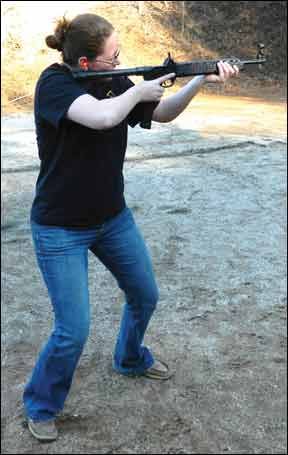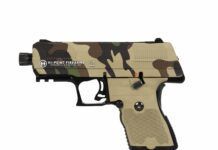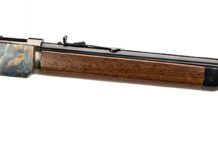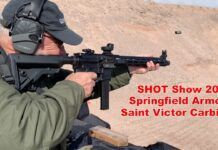When it comes to personal defense, competition, and recreational shooting, the most popular rifle in America is likely the AR-15 chambered for .223 Remington. But there are still plenty of shooters who prefer the light recoil and low expense of 9mm Luger ammunition. Whereas caliber .223 is strictly the staple of rifle shooters, 9mm carbines are often used by pistol shooters who sometimes use a long gun. There are three basic types of 9mm carbine. They are the 9mm AR-15, semi-automatic versions of submachineguns such as the UZI, and purpose-built 9mm carbines that more or less follow their own rules of design. In this test we’ll fire the $409 Kel-Tec Sub 2000 9mm, the $700 Thureon Defense 9mm, and Norinco’s $800 UZI 9mm carbines. In addition we will also evaluate a 9mm conversion unit, the $505 MechTech Systems Carbine Conversion Unit for Glock. Our goal was to evaluate each carbine on its own merits and then compare the three types of design for personal defense.

Our choice of test ammunition was Winchester USA 115-grain FMJ rounds and two loads from Black Hills Ammunition topped with 124-grain bullets. One featured a full-metal-jacketed slug and the other a jacketed hollowpoint driven by a +P charge. Each carbine was tested for accuracy from the 50-yard bench using only their supplied open sights.
Kel-Tec Sub 2000 9mm, $409
The Kel-Tec Sub 2000 represents a purpose-built 9mm carbine for civilian defense. There is no fully automatic equivalent military or otherwise. The Sub 2000 offered a modern appearance with the most efficient use of CNC machinery. It was not only compact in full-ready posture, but the carbine folded into a neat carry package. The folding joint was located just ahead of the trigger guard. To fold the Sub 2000, the trigger guard was pulled forward to release the hinged frame. The gun could then be locked into the folded position. In this condition the Sub 2000 measured just over 16 inches long and could be easily carried in a briefcase, range bag, or inside a vehicle. For example, one of our raters drives a Toyota pickup truck of modest interior dimensions. Once folded, the Kel-Tec stowed easily behind the driver’s seat and could be made ready for action instantly when the seat was pulled up. The other carbines needed to be carried with the muzzle toward the passenger, offering only more conventional access.
According to the manufacturer’s website, KelTecWeapons.com, the Sub 2000 can be configured to accommodate 9mm magazines from other pistols such as the Beretta 92, Sig Sauer’s P226, and the Smith & Wesson Model 59. But all of the 9mm Kel-Tec carbines we have seen have been suited to Glock 17 magazines. (You may shorten the grip with a bit of filing to convince the rifle to take Glock 19 magazines, and there is also a factory-available Glock 19 grip variant.) The Kel-Tec may also be used with Glock’s 33-round 9mm magazines for a superior reserve of firepower or just more fun. The magazines fit into the grip frame in proven UZI fashion. The idea is that two hands meet easily even in total darkness and that reloading was simple and practically automatic.

The bolt was made ready by pressing on the cocking handle and driving it to the rear. The bolt handle was located in the stock. Locating it beneath the carrying handle seemed to make the Kel-Tec carbine more compact. But when firing the Kel-Tec Sub 2000, it’s best to keep your hands out of the way of the reciprocating bolt handle.
The trigger was average for a commercial self loader but smooth without noticeable creep and only modest backlash. We spent considerable time getting used to manipulating the crossbolt safety. But once it became familiar, we thought it was as good as most commercial designs in terms of speed. The Sub 2000 didn’t offer the facility on which to mount an optical sight, which would be a big plus in today’s market. Nevertheless, the supplied sights, including a front post that was bright red and protected by a round cover, proved to be excellent for close-quarters combat. Combined with the Kel-Tec’s light weight, the sights enabled us to move the Sub 2000 quickly on target.
The proof was in the firing. Whereas the 115-grain 9mm is perhaps the most typical weight for inexpensive loads, we think 124-grain FMJ ammunition may be the ideal shooting weight for a 9mm carbine, as it offers greater momentum for function. Especially when it is used in a carbine with heavy springs or with a dirty firearm. But there were no malfunctions with either type of ammunition. Recoil was light overall, but still more than was experienced when firing other carbines, probably due to the Kel-Tec’s lighter weight.
In terms of accuracy, it was easy to bring the Kel-Tec to the target and eat the center out of the X ring at 15 yards while keeping the front sight on target. However, this carbine required considerable practice in manipulating the bolt to quickly make it ready. This is important because most experts agree that it is advisable to keep a long gun’s chamber empty while it stands ready for home defense.
When moving to the potent Black Hills 124-grain JHP +P, we felt a difference in recoil that wasn’t as noticeable with the other carbines. Felt recoil was not offensive by any means, but when you are using a load that generates over 600 foot-pounds of energy, there must be some type of push. If you deploy a good 9mm carbine, you want to maximize the caliber and these +P rounds do just that. Seasoned shooters will not be affected, but less experienced shooters purchasing this carbine for home defense may find the increase in recoil more noticeable.
Settling down to 50-yard accuracy testing, the Kel-Tec proved accurate enough for pest control and even small game hunting. Handling was rated quick at short range but not quite as stable as the other carbines. While we limited the most extensive testing to the aforementioned ammo types, we also tested a number of competing 9mm loads. The Kel-Tec demonstrated a high level of reliability throughout.
Our Team Said: The Kel-Tec always worked. It was reliable, and while it was the least accurate overall of the carbines tested, this must be kept in perspective. All of the carbines practically cut one hole at 15 yards. Are you really more formidable with one of these carbines than another in all scenarios? Tactically they are quite similar as well. If the motivation for purchase is home defense, the Kel-Tec has the advantages of affordability and light weight plus the availability and interchangeability of magazines with the Glock pistol. Running a tactical course that simulates the home at room-size distances shows that the Kel-Tec is a first choice for home defense. It is simply fast handling. As a car gun, it is far more formidable than a pistol but relatively light and fast into action. The Kel-Tec is a Best Buy, based upon credible performance, affordability, and easy-to-find accessories.
Thureon Defense Carbine 9mm, $700
This is the newest design among the carbines. Someone asked why not simply choose a 9mm upper for your AR-15? There are several good replies. First, we may not have an AR-15. Second, we may not wish to own a .223 rifle. Perhaps the most pertinent answer is that a rifle with two uppers is still just one rifle, and two rifles are two rifles. The Thureon carbine looks like a blend of a Sten and a Colt AR-15. This 9mm has purposeful lines, but it isn’t pretty. The original Thureon used modified UZI magazines, but our carbine was Glock compatible. We remember the 9mm Colt and its seemingly nonexistent replacement magazines, so using the UZI magazine was a good thing. But in the interest of availability, the Glock is even better.
The handguard was a circular, ventilated type that is about 1.45 inches in diameter. The 16-inch-plus barrel featured a flash suppressor. How much of an aid the suppressor was we may only hazard, but the rifle didn’t have much muzzle rise. While it isn’t an AR, it was built on similar handling and should be evaluated as such. The receiver halves fit together well. The trigger action was typical AR-15 in operation but broke cleaner than most, in our view. The buttstock was advertised with adjustments ranging from about 32 inches to just over 35.6 inches. Large- and small-framed shooters or those wearing heavy clothing or a vest will find this carbine fits them with the proper adjustment. The pistol grip, location of the safety and other controls were straightforward AR-15 design. However, our example was fitted with the optional Slide Fire stock. This feature turns the weapon into an externally driven machine gun of sorts. For the purposes of this test we kept this feature locked out. The only downside to our test procedure was that even when locked in the normal position, the stock was a bit loose. We exhibited pressure on the stock to be certain that the accuracy testing was viable.
We think that the Thureon came on board with an advantage in the firing tests. It is difficult to find an interested shooter without AR-15 experience, and every single rater had experience with the AR-15 and plenty of muscle memory to draw from. The other guns had to hit the ground running just to keep up. Everyone liked the way the Thureon handled, which was similar to the AR-15, but most raters felt it handled even a bit faster. That is good handling! The charging handle on the side of the receiver was a departure from the AR-15 norm, but no one criticized. The Thureon was fired without malfunction. Like all other quality firearms, the carbines preferred one load to the other. But the Kel-Tec or UZI-type carbines tend to produce more or less the same results with all types of ammunition. However, the Thureon displayed at least acceptable accuracy with some loads and exceptional accuracy with others. Choosing to experiment with additional loads such as Fiocchi 123-grain FMJ ammunition (a round that one of our raters swears by for good results), the Thureon produced 2-inch 50-yard groups, excellent for this type of rifle. This was despite the fact that some felt that the sights of the Thureon could have been better. Both the front and rear sights were located on the receiver, rather than offering a front sight mounted on the end of the barrel. That the Thureon invites the shooter to challenge the 50-yard line with only open sights is, in our view, a testament to the product.
If we may discuss intangibles briefly, there is a good chance that the Thureon 9mm, coupled with a hard-hitting 9mm loading such as the Black Hills 124-grain +P, may be a suitable weapon for taking out coyote at a long 100 yards. We feel that the 9mm Luger cartridge gives its best performance inside 100 yards, and in that range the Thureon carbine maximizes the caliber. Despite the much touted “hands meeting in the dark” magazine change for both the UZI and the Kel-Tec, the Thureon proved to be sure and positive in magazine changes. Hitting the magazine release and quickly canting the magazine into the well and snapping it into place produced brilliant elapsed times.
A few words on the Slide Fire stock; we did not like it that much. The Slide Fire works by pressing forward on the forend while you keep the trigger finger on the stock. The finger is then pressed into the trigger and the recoil of the carbine keeps the finger moving until you remove your finger from the trigger or release forward pressure to the forend. Under nonstop rapid-fire, a rifle magazine can be emptied in a few seconds. It is a poor man’s automatic fire, completely legal, being delivered with a letter from the ATF stating it is legal. It’s a ball of fun that will appeal to some shooters. But, in our view, there is nothing accomplished by such rapid fire that cannot be achieved by quick, controlled semi-automatic fire.
Our Team Said: The Thureon is the strong first choice for anyone interested in gilt-edged accuracy, allowing the shooter to explore just what a 9mm carbine will do. The Thureon is cost effective and should provide cheap, accurate plinking from long range. A handloading program with +P loads might also allow you to take out a wily coyote far past 9mm pistol range. Either way, as a fighting carbine for the worst-case scenario, the Thureon wins by a considerable margin.
Norinco UZI 9mm, $800
The UZI was easily the oldest design tested, with the first examples delivered to the Israeli Defense Forces in the early 1950s. The Norinco UZI 9mm was modified from the fully automatic open-bolt design to a closed-bolt semiautomatic. The integrity of the design, and not incidentally the reliability of the UZI, was maintained, and there were no firing malfunctions of any type during our test.
The UZI is a proven design with much to recommend. However, since it may be fairly categorized as a converted submachinegun, there were some oddities. The barrel must be 16 inches long to remain of legal length. The result looks a bit odd, particularly if a folding stock is deployed. The full-auto UZI was heavy, but by all reports, it was one of the more controllable SMG designs. As a one-shot-per-trigger-press carbine, its weight becomes more noticeable. The barrel telescoped over the bolt, allowing a relatively compact receiver for the barrel length, and the magazine in the grip handle has its advantages. It has often been said that to load the UZI in the dark, simply bring your hands together and insert the magazine. The design works well but equal speed may be had with other designs. The UZI was designed for ease of manufacture, relative to the time. It isn’t quite as cheap to manufacture in today’s world, and rather than a high-rate-of-manufacture military weapon, we now see the UZI as a desirable firearm in a limited market niche.
The folding stock of the original UZI allowed for compact carry. The UZI may be fired with the stock folded, but we recommend that you keep the stock extended when firing if you wish to hit anything. The forend was comfortable enough, and the sights were a good example of battle sights. The trigger action was a bit heavy at 8 pounds, but controllable with practice. We suspect that in the original design UZI Gal was more concerned with the trigger running away in automatic fire than with precision. The SMG heritage is way cool for looks, history, and emotional attachment, but perhaps not so cool for precision shooting.
The cocking bolt was located on top of the receiver. It was difficult to operate quickly due to the weight of the recoil spring. The bolt raceway was effectively sealed from grit and debris, giving the UZI a leg up in terms of reliability. A little more than half of the barrel was exposed beyond the receiver.
So, when the stock was folded, the UZI measured about 18 inches overall. That’s about as short as you are going to get with a 9mm carbine.
Several of our raters have experience with the UZI, and their experience with the folding stock has been positive. However, the UZI we located for use in our comparison was the Norinco version. This type was more roughly made that the original, or the Action Arms versions. The preposterous wooden stock was overly thick at the pistol grip. During firing we experienced a few missteps in fully depressing the grip safety due its location and the extra thick wooden grip. The grip safety is a good idea, deactivating the trigger if the UZI is dropped.
But in the case of our test carbine, the wooden “assault ban compatible stock” design was, in our opinion, compromised. Conversely most agreed that the shoulder-stock arrangement of the Norinco, mandated at the time of importation by the crime bill (It’s a crime, Bill!) did offer greater stability.
Firing the Norinco UZI 9mm was uneventful. The piece fed, chambered, fired, and ejected with regularity. For a firearm originally intended to give a radius of dispersion rather than pinpoint accuracy, the UZI did well. The only problem experienced was an odd one that manifested itself from time to time. The bolt was racked for firing without incident most of the time. Occasionally the bolt refused to rack. We could not budge it. We shook the gun, pressed the bolt forward, took out the magazine, and sometimes simply laid the piece aside. Then for seemingly no reason the bolt racked just fine, and continued to do so for hundreds of rounds before acting up again.
Then there were numerous incidents in which the bolt did not fully seat forward during cycling. Perhaps heavier loads would have done better, but the carbine did not sail smoothly with the same loads used in our other carbines.
When comparing the speed of magazine changes with AR-15 type weapons such as the Thureon 9mm carbine, the Thureon was actually faster. Not by a compelling margin, but hands down over the course of many timed runs. Unless you are in the dark in a trench and have to go by feel, then the UZI wins. However, the UZI and the Kel-Tec magazines do end up protruding further than the AR types due to their location.
The UZI proved more accurate than the Kel-Tec but the best results exhibited by the Thureon were not realized. We had imagined that this heavy carbine would be more accurate than it proved. But chances are a true UZI may be more accurate than the Norinco.
Our Team Said: Whether you envision the use of the UZI by the IDF against overwhelming odds or the famous images of the Secret Service deploying the UZI, this is a carbine with an unmistakable profile and heritage. The UZI is proven but not perfect. The magazine protrudes awkwardly if you fire from the prone position, and the metal folding stock will become hot and cold along with the weather. It just looks right and this is one case in which a sense of history is overwhelming. But there was some operational interference due to the supplied wooden stock.
MechTech Systems Carbine Conversion Unit for Glock 9mm, $505
This is a different piece because it isn’t a firearm at all but a conversion unit. While more complex than a .22-caliber conversion unit and the like, it is a bona fide accessory rather than a firearm. These conversions are available for the 1911 and the Glock, and we chose the Glock 19 9mm conversion for our test.
By removing the slide of the Glock and fitting the receiver into the MechTech conversion, you have a light, handy carbine. When assembling the Glock conversion, it is vital that a piece known as the Glock Block be included. This piece ensures reliable feeding and takes the place of the Glock’s integral feed ramp, once the barrel is removed along with the slide from the original pistol. In common with the 1911 conversion, there was no manual safety.
What’s left was the Glock double-action-only trigger action and the Glock trigger lever. The MechTech conversion worked well, was reasonably fast handling, and proved accurate. The problem is that you have to have another firearm to make this one ready. We can see a shooter who normally carries a Glock 9mm using this conversion for small game or predator shooting. Or, if you are camping or staying at a cabin, you may wish to have something more formidable on hand than a pistol.
The carbine was simple to set up and greatly increased the practical accuracy and hit potential from that of the handgun. Like each of our test carbines, we recommend keeping the MechTech ready for home defense with the chamber empty. Even though the Glock itself is safe enough when fully loaded, a carbine with a dissimilar sear and bolt arrangement is a different matter.
The MechTech conversion is an interesting option that adds to the utility of the Glock pistol without any legal wrangling. No paperwork was involved because it is not a firearm. The base price was reasonable, in our opinion, for such high quality. But adding a fixed carrying handle rear sight, post front sight and adjustable stock did increase the price of the conversion over the base unit’s cost.
Our Team Said: This was a good conversion, but the result was less practical than our other test guns, which were full-time carbines. However, for what is basically a gun part to win a B rating against a purpose-designed carbine such as the Thureon was, in our view, most impressive. If we were comparing conversion units, this one would get a solid A+, our testers said. The MechTech Systems Carbine Conversion Unit for Glock is one accessory that is difficult to ignore.
0612-9MM-CARBINE-ACC-AND-CHRONO.pdf
0612-THUREON-DEFENSE-CARBINE-9MM.pdf




























